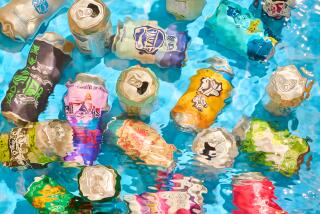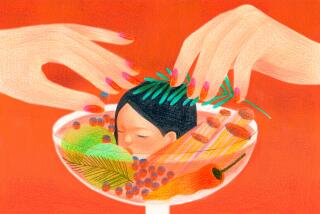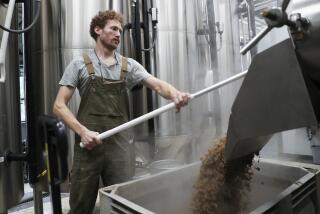Quaffology 101: How to really appreciate a beer
Oh, you think you already know how to drink beer. Grab the bottle from the fridge, pop the top and pour it down the hatch.
That’s not drinking beer. It’s just getting it inside you. Sure, after mowing the lawn, maybe that’s all you’re after, but some of this stuff actually has flavor.
Quite a lot of it these days, in fact. Not only can we get the great English and Belgian ales, but out here on the West Coast we have a bright new generation of craft brewers. Last year, sales of craft beers in the United States were up 7%, a higher growth than imported or mainstream beers enjoyed.
So we know you’re buying a lot of good beer. You might as well enjoy the flavor.
You were right about the first step -- taking the beer out of the fridge. But now put it on the counter and leave it there five or 10 minutes before drinking it. Sure, beer is fragile and needs to be refrigerated, but when it’s ice cold, it has scarcely any aroma. It should be about halfway between refrigerator temperature and room temperature, around 50 degrees for lagers and up to 60 for ales.
And you were right about opening it, but once you do, don’t chug it straight from the bottle -- not if you want to taste it. Beer is largely about the bubbles, and the bubbles need to run free, and that means in a glass.
As long as the beer is under pressure in a bottle (or keg, or cask), it’s stable; the water and carbon dioxide molecules stick together. But when the beer is poured out, it gets shaken, and the agitation makes the bonds break, releasing the CO2 as bubbles.
In a glass, those bubbles form a head, and that’s where the aromatics in the beer congregate. The bubbles loft them into the air, just as they do in Champagne. If you drink from the bottle, or pour without creating a head in the glass, they can’t do their job, and you miss out on most of the flavor.
Give it some air
One of the differences between bottled beer and draft is that by the time draft is poured into your glass, it’s already been agitated by traveling through the hose to the tap. So in effect, it’s been poured twice, and this is why draft beer is known for being aromatic and having a soft head.
But that doesn’t mean draft is automatically better. If everything’s done right, bottled beer can have just as much aroma, and its pricklier carbonation gives it more liveliness. (This is why a brewer will package the same beer differently for bottle, under higher pressure, than for draft.)
So pour boldly at first -- splash it right in there to make a good head of foam. Then pour the rest of the bottle gently down the side of the glass under the head, because you want to leave plenty of carbonation in the beer. Beer doesn’t have the attractive fruit acidity that wine has. Without bubbles exploding in your mouth, it’s flat -- bland and syrupy.
Beer is not terribly picky about what kind of glass you use, as long as the mouth is wide enough for the aromas to spread, but not so wide that they dissipate (a giant frosted beer mug is for chugging, not tasting).
Likewise, the glass should be deep enough that the head doesn’t rise to the rim, taking up all the room for the bouquet to develop.
One thing: If you want a good head of foam, the glass has to be squeaky clean. Oil or soap residue interferes with foaming. In fact, if a glass starts to bubble over, you can stop it by touching the foam with your fingertip, just because of the oils in your skin.
Now swirl the glass a little to get the whole aroma. You’ll get that dry, crisp, bready effect of lager or the spicier aroma of an ale, maybe with some dried fruit aromas. And, of course, the resinous, bay leaf-like smell of hops.
If a beer is made with one of the fancier varieties of hops, there may be pine or citrus notes. Some West Coast craft brewers use the ultra-piney Cascade variety of hops, which can also have flowery notes.
Beware of skunks
Here’s something you don’t want to smell: skunkiness. That’s when the beer smells unpleasantly organic, like rotting cheese, say. Or when a beer smells warm and “cooked” even though it’s cold. It can develop when a green bottle is exposed to sunlight, because one of the acids in hops goes nuts under light in the blue-green spectrum and attacks other components in the beer, creating the skunk smell. Beer in brown bottles doesn’t have such a problem.
Skunkiness is quite common. Some Americans think it’s a natural part of the flavor of certain imported lagers that come in green bottles. It isn’t, and if you go to Europe, you’ll see those same beers being sold in brown bottles. Why brewers have decided Americans prefer beer in green glass is a mystery.
It happens in domestic beer too. One glass in a six-pack might be skunky and the rest all right, or they might all have a stink. Here’s all you can to: Avoid green bottles and do what you can to keep beer away from sunlight.
Another thing you don’t want to smell is the flat, cardboard-y aroma of oxidation, the tombstone that stands where the lively flavors of fresh beer once flourished. Avoiding skunky and cardboard-y smells may be why so many people drink beer straight from the bottle.
Oxidized beers also develop a harsh taste in the mouth, unlike the bracing bitterness of hops. The TV ads denouncing “bitter beer” are probably a response to this nasty flavor.
The fact is, distributors often mishandle beer. They leave it in warehouses for weeks, or out on loading docks in all sorts of weather, the way it would never occur to them to treat wine (which can actually take rougher treatment than beer can).
One reason that draft beer has such a good reputation is that casks and kegs are stored and shipped under refrigeration. Bottled beer, because it’s likely to be handled carelessly, is usually pasteurized in the hope of protecting it from the worst of this sort of treatment, but pasteurizing takes out part of the flavor. (One reason that Sierra Nevada has such a following is that its beer, unpasteurized like most craft beers, is shipped only under carefully controlled refrigeration conditions.)
Now drink
The final step -- we know you’ve been waiting for this, pally -- is to take a mouthful of the beer. Slurp it and suck a little air through it to bring out the flavors -- the caramel-like sweetness of the malt, the bitterness from the hops, the mouth-coating savoriness of the malt proteins. Savor the aromas of the hops and the roasted qualities of the malt a second time as the fumes rise from your mouth into your nose.
You know what? You may find that you won’t just chug the bottle down, no more than you’d wolf a good steak. You’ll relish every mouthful.
You’ve earned this. You’ve treated the beer with respect, and it should be treating you well in return. Beer can be your buddy.
*
(BEGIN TEXT OF INFOBOX)
Assessing a beer: Sniff, swirl and sip
A delicately floral and herbaceous nose, redolent of hibiscus flowers and a fresh bouquet garni. A soft and velvety mouth-feel, gently tannic with a lingering spicy, tart finish. A newly released Santa Barbara Pinot Noir? No, I’m describing the Craftsman Triple White Sage, a Belgian-style golden ale brewed by a tiny artisanal brewery in Pasadena. That’s right, a beer.
The methods of professionally evaluating beer are practically the same as those used to evaluate wine. However, beer does have unique properties and thus a few rules to consider. As the chef-owner of Father’s Office in Santa Monica, I routinely taste and appraise beers for our seasonally changing list of more than 50 different selections.
Here’s how I professionally judge a beer:
First, the beer, especially if it’s a highly aromatic ale, should be at about 55 degrees -- wine cellar temperature. Just as it’s harder to tell if a white wine is corked if it’s too cold, excessively cold temperatures will not only mask the beer’s delicate flavors but also any flaws it might have.
I pour a little of the beer, about 4 ounces or so, into a 24-ounce red burgundy glass. The oversized balloon shape of the glass allows for aeration just like it does for Pinot Noir. Then I swirl and agitate the beer, bringing the bubbles and aromatics to the surface. At this point, I put my nose into the glass, below the rim, and take a big whiff.
If the beer has any off aromas, I stop right here and dump it. If it’s OK, I swirl and smell again. This time, I’m looking for the top notes of aromatics that generally reveal the floral aspect of the hops that might have been used. I might smell pine, resin, citrus rind or chamomile tea. If hops are not the dominant aroma, yeast will be the next obvious character. A strong presence of yeast will reveal notes of ripe tropical fruit, bread dough and perhaps even warm spices such as cloves or coriander.
Next, I hold the glass up to the light to get a good look at the beer’s color, which is determined by the amount of extraction from the roasted malts. The darker the barley malts are roasted, the darker the beer will be. A darker color generally indicates deeper flavors such as toffee, nuts, espresso and caramel.
I also note the beer’s clarity. If it’s hazy, that generally means unfiltered yeast is present. Many Belgian beers are packaged with live yeast, often to promote subsequent fermentations in the bottle. Yeast in the bottle also adds texture to the mouth-feel and contributes to the beer’s shelf life.
Now I take a small sip, tilting my head slightly forward and holding the beer under my tongue. I open my mouth slightly and inhale gently through my mouth. This draws air across the beer and allows me to swallow slowly. At this point, I might find even more aromatics, such as vegetal or medicinal fragrances.
I take a bigger sip and swish around my mouth for a few seconds. I’m considering the viscosity and weight of the beer. More viscous means more malts and usually higher alcohol. Malt generally makes up the mid-palate of a beer.
The finish might reveal the bitterness of the hops and perhaps the origin of their terroir, if only a single variety was used. (Most brewers generally blend several hop varieties for complexity.)
If yeast is dominant in the aromatics, such as in a Belgian Trappist Ale, I would generally expect a lingering and complex finish involving spice and dried dark fruits such as prunes or black raisins.
-- Sang Yoon
More to Read
Eat your way across L.A.
Get our weekly Tasting Notes newsletter for reviews, news and more.
You may occasionally receive promotional content from the Los Angeles Times.










